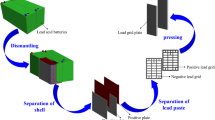Abstract
The lead (Pb) electro-refining in the green methanesulfonic acid (MSA) system presents an alternative route to the conventional fluosilicic-acid-based Pb electro-refining. Herein, we investigated the electro-deposition behavior of the MSA-based Pb electro-refining by electrochemical measurement and apparent characterization techniques. The operational principle of the Pb deposition was preliminarily understood by performing cyclic voltammetry (CV) complemented with SEM–EDS detection. The results indicated the thermodynamic priority of the efficient Pb2+/Pb reduction reaction over the H+/H2 one. The impact of various factors such as MSA concentration, scanning rate, and temperature on the effectiveness of Pb electro-deposition were investigated by linear sweep voltammetry and electrochemical impedance spectroscopy. Further numeric calculation and model analysis helped acquire in-depth kinetics and mechanism knowledge, such as the discharge form of divalent Pb(II), reversibility of the electrode process, apparent activation energy, reaction order and deposition reaction kinetics. Overall, this work revealed important electrochemical mechanism, principle, and kinetics of the Pb deposition in the MSA-based electro-refining process and would offer a significant guidance in condition optimization of its practice.
Graphical Abstract







Similar content being viewed by others
References
Chang C, Li YG, Chen YM et al (2020) Lead electrodeposition in methanesulfonic acid system. Min Metall Eng 40(01):105–108+113. https://doi.org/10.3969/j.issn.0253-6099.2020.01.025
Baker C, Kelly PD, Murrell CJ (1991) Microbial degradation of methanesulphonic acid: a missing link in the biogeochemical sulphur cycle. Nature 350:627–628. https://doi.org/10.1038/350627a0
Gernon MD, Wu M, Buszta T et al (1999) Environmental benefits of methane sulfonic acid. Comparative properties and advantages. Green Chem 1(3):127–140. https://doi.org/10.1039/A900157C
Yang SH, Wu YZ, Sun YW et al (2018) Electrochemistry of anodic reactions in MSA system during electrowinning of lead. Hydrometall China 37:356–361, 367. https://doi.org/10.13355/j.cnki.sfyj.2018.05.004
Lin XH, Fei JY, Tuo LL et al (2014) Effect of methanesulfonate fast nickel plating process parameters on the internal stress of the plated layer. Mater Prod 47(8):10–14. https://doi.org/10.16577/j.cnki.42-1215/tb.2014.08.001
Hasan M, Rohan JF (2010) Cu electrodeposition from methanesulfonate electrolytes for ULSI and MEMS applications. J Electrochem Soc 157(5):D278–D282. https://doi.org/10.1149/1.3332729
Li YG, He J, Liao FW et al (2019) Mechanism of third phase elimination and demulsification during indium extraction from methanesulfonic acid solution. Min Metall Eng 39(5):65–68
Walsh FC, Deleon CP (2014) Versatile electrochemical coatings and surface layers from aqueous methane sulfonic acid. Surf Coat Technol 259:676–697. https://doi.org/10.1016/j.surfcoat.2014.10.010
Zhang Z, Wu GH, Yi ZB et al (2013) Present research situation on methylsulfonate tin and tin alloy plating. Hunan Nonferrous Met 29(2):36–39. https://doi.org/10.3969/j.issn.1003-5540.2013.02.012
Pewnim N, Roy S (2013) Electrodeposition of tin-rich Cu–Sn alloys from a methane sulfonic acid electrolyte. Electrochim Acta 90:498–506. https://doi.org/10.1016/j.electacta.2012.12.053
Bengoa LN, Pary P, Conconi MS et al (2017) Electrodeposition of Cu–Sn alloys from a methane sulfonic acid electrolyte containing benzyl alcohol. Electrochim Acta 256:211–219. https://doi.org/10.1016/j.electacta.2017.10.027
Jin B, Dreisinger DB (2016) A green electrorefining process for production of pure lead from methanesulfonic acid medium. Sep Purif Technol 170:199–207. https://doi.org/10.1016/j.seppur.2016.06.050
Brad AJ, Faulkner LR (2000) Electrochemical methods: fundamentals and applications. https://www.researchgate.net/publication/257978943_Electrochemical_Methods_Fundamentals_and_Applications
Berzins T, Delahay P (1953) Oscillographic polarographic waves for the reversible deposition of metals on solid electrodes. J Am Chem Soc 75(3):555–559. https://doi.org/10.1021/ja01099a013
Wang CH, Yang SH, Chen YM et al (2015) Effect of bromide ions on the corrosion behavior of hafnium in anhydrous ethanol. RSC Adv 5:34580–34587. https://doi.org/10.1039/C5RA02233A
Wang CH, Yang SH, Chen YM (2019) Electrochemical behaviour of hydrogen evolution reaction on platinum in anhydrous ethanol containing tetraethylammonium bromide. J Appl Electrochem 49(6):539–550. https://doi.org/10.1007/s10800-019-01301-6
Wang CH, Yang SH, Chen YM et al (2017) Electrochemical behaviour of hafnium in anhydrous n-butanol containing tetraethylammonium bromide. Int J Electrochem Sci 12(1):545–560. https://doi.org/10.1007/s10800-019-01301-6
Wang CH, Yang SH, Yuan Y et al (2017) Corrosion behavior of hafnium in anhydrous isopropanol and acetonitrile solutions containing bromide ions. Trans Nonferrous Met Soc China. https://doi.org/10.1016/S1003-6326(17)60214-0
Zhang JQ (2009) Electroplating process and mechanism of tin-silver-copper alloy and solder properties of Deposits. Dissertation for the Doctoral Degree in Engineering. Harbin Institute of Technology, Harbin. https://doi.org/10.7666/d.D257917
Chen MJ, Shiu YJ, Lin CH (2009) Recovery of lead from spent lead batteries by hydrometallurgical method. Chin J Process Eng S2:71–75
Wang CH, Jiang KQ, Jones TW et al (2022) Electrowinning-coupled CO2 capture with energy-efficient absorbent regeneration: towards practical application. Chem Eng J 427(7774):131981. https://doi.org/10.1016/j.cej.2021.131981
Acknowledgements
This research was supported by BASF New Material Lead Methanesulfonic Acid System Lead Electrolytic Refining Project (No. 738010278) and the Natural Science Foundation of Hunan Province of China for Youths (No. 2020JJ5628).
Author information
Authors and Affiliations
Corresponding authors
Ethics declarations
Conflict of interest
The authors declare no competing interests.
Additional information
The contributing editor for this article was Adam Clayton Powell.
Publisher's Note
Springer Nature remains neutral with regard to jurisdictional claims in published maps and institutional affiliations.
Supplementary Information
Below is the link to the electronic supplementary material.
Rights and permissions
About this article
Cite this article
Li, Yg., Liu, Ss., Wang, Ch. et al. Electro-Deposition Behavior in Methanesulfonic-Acid-Based Lead Electro-Refining. J. Sustain. Metall. 7, 1910–1916 (2021). https://doi.org/10.1007/s40831-021-00467-8
Received:
Accepted:
Published:
Issue Date:
DOI: https://doi.org/10.1007/s40831-021-00467-8




